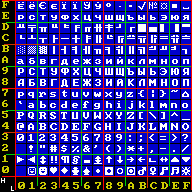Related Research Articles
ISO/IEC 8859-15:1999, Information technology — 8-bit single-byte coded graphic character sets — Part 15: Latin alphabet No. 9, is part of the ISO/IEC 8859 series of ASCII-based standard character encodings, first edition published in 1999. It is informally referred to as Latin-9. It is similar to ISO 8859-1, and thus also intended for “Western European” languages, but replaces some less common symbols with the euro sign and some letters that were deemed necessary: This encoding is by far most used, close to half the use, by German, though this is the least used encoding for German.
ISO/IEC 8859-3:1999, Information technology — 8-bit single-byte coded graphic character sets — Part 3: Latin alphabet No. 3, is part of the ISO/IEC 8859 series of ASCII-based standard character encodings, first edition published in 1988. It is informally referred to as Latin-3 or South European. It was designed to cover Turkish, Maltese and Esperanto, though the introduction of ISO/IEC 8859-9 superseded it for Turkish. The encoding was popular for users of Esperanto, but fell out of use as application support for Unicode became more common.

Windows-1252 or CP-1252 is a single-byte character encoding of the Latin alphabet that was used by default in Microsoft Windows for English and many Romance and Germanic languages including Spanish, Portuguese, French, and German. This character-encoding scheme is used throughout the Americas, Western Europe, Oceania, and much of Africa.
ISO/IEC 8859-11:2001, Information technology — 8-bit single-byte coded graphic character sets — Part 11: Latin/Thai alphabet, is part of the ISO/IEC 8859 series of ASCII-based standard character encodings, first edition published in 2001. It is informally referred to as Latin/Thai. It is nearly identical to the national Thai standard TIS-620 (1990). The sole difference is that ISO/IEC 8859-11 allocates non-breaking space to code 0xA0, while TIS-620 leaves it undefined.
ISO/IEC 8859-8, Information technology — 8-bit single-byte coded graphic character sets — Part 8: Latin/Hebrew alphabet, is part of the ISO/IEC 8859 series of ASCII-based standard character encodings. ISO/IEC 8859-8:1999 from 1999 represents its second and current revision, preceded by the first edition ISO/IEC 8859-8:1988 in 1988. It is informally referred to as Latin/Hebrew. ISO/IEC 8859-8 covers all the Hebrew letters, but no Hebrew vowel signs. IBM assigned code page 916 to it. This character set was also adopted by Israeli Standard SI1311:2002, with some extensions.
ISO/IEC 8859-4:1998, Information technology — 8-bit single-byte coded graphic character sets — Part 4: Latin alphabet No. 4, is part of the ISO/IEC 8859 series of ASCII-based standard character encodings, first edition published in 1988. It is informally referred to as Latin-4 or North European. It was designed to cover Estonian, Latvian, Lithuanian, Greenlandic, and Sámi. It has been largely superseded by ISO/IEC 8859-10 and Unicode. Microsoft has assigned code page 28594 a.k.a. Windows-28594 to ISO-8859-4 in Windows. IBM has assigned code page 914 to ISO 8859-4.
ISO/IEC 8859-6:1999, Information technology — 8-bit single-byte coded graphic character sets — Part 6: Latin/Arabic alphabet, is part of the ISO/IEC 8859 series of ASCII-based standard character encodings, first edition published in 1987. It is informally referred to as Latin/Arabic. It was designed to cover Arabic. Only nominal letters are encoded, no preshaped forms of the letters, so shaping processing is required for display. It does not include the extra letters needed to write most Arabic-script languages other than Arabic itself.
ISO/IEC 8859-7:2003, Information technology — 8-bit single-byte coded graphic character sets — Part 7: Latin/Greek alphabet, is part of the ISO/IEC 8859 series of ASCII-based standard character encodings, first edition published in 1987. It is informally referred to as Latin/Greek. It was designed to cover the modern Greek language. The original 1987 version of the standard had the same character assignments as the Greek national standard ELOT 928, published in 1986. The table in this article shows the updated 2003 version which adds three characters. Microsoft has assigned code page 28597 a.k.a. Windows-28597 to ISO-8859-7 in Windows. IBM has assigned code page 813 to ISO 8859-7. (IBM CCSID 813 is the original encoding. CCSID 4909 adds the euro sign. CCSID 9005 further adds the drachma sign and ypogegrammeni.)
ISO/IEC 8859-9:1999, Information technology — 8-bit single-byte coded graphic character sets — Part 9: Latin alphabet No. 5, is part of the ISO/IEC 8859 series of ASCII-based standard character encodings, first edition published in 1989. It is designated ECMA-128 by Ecma International and TS 5881 as a Turkish standard. It is informally referred to as Latin-5 or Turkish. It was designed to cover the Turkish language, designed as being of more use than the ISO/IEC 8859-3 encoding. It is identical to ISO/IEC 8859-1 except for the replacement of six Icelandic characters with characters unique to the Turkish alphabet. And the uppercase of i is İ; the lowercase of I is ı.
Windows-1258 is a code page used in Microsoft Windows to represent Vietnamese texts. It makes use of combining diacritical marks.
Windows-1251 is an 8-bit character encoding, designed to cover languages that use the Cyrillic script such as Russian, Ukrainian, Belarusian, Bulgarian, Serbian Cyrillic, Macedonian and other languages.

Code page 866 is a code page used under DOS and OS/2 in Russia to write Cyrillic script. It is based on the "alternative code page" developed in 1984 in IHNA AS USSR and published in 1986 by a research group at the Academy of Science of the USSR. The code page was widely used during the DOS era because it preserves all of the pseudographic symbols of code page 437 and maintains alphabetic order of Cyrillic letters. Initially this encoding was only available in the Russian version of MS-DOS 4.01 (1990), but with MS-DOS 6.22 it became available in any language version.
Windows-1250 is a code page used under Microsoft Windows to represent texts in Central European and Eastern European languages that use the Latin script. It is primarily used by Czech, though Czech has now moved to UTF-8 and mostly abandoned this legacy encoding. It is also used for Polish, Slovak, Hungarian, Slovene, Serbo-Croatian, Romanian, Rotokas and Albanian. It may also be used with the German language, though it's missing uppercase ẞ. German-language texts encoded with Windows-1250 and Windows-1252 are identical.
Windows code page 1253, commonly known by its IANA-registered name Windows-1253 or abbreviated as cp1253, is a Microsoft Windows code page used to write modern Greek. It is not capable of supporting the older polytonic Greek.
Windows-1255 is a code page used under Microsoft Windows to write Hebrew. It is an almost compatible superset of ISO-8859-8 – most of the symbols are in the same positions, but Windows-1255 adds vowel-points and other signs in lower positions.
Windows-1256 is a code page used under Microsoft Windows to write Arabic and other languages that use Arabic script, such as Persian and Urdu.
Windows-1257 is an 8-bit, single-byte extended ASCII code page used to support the Estonian, Latvian and Lithuanian languages under Microsoft Windows. In Lithuania, it is standardised as LST 1590-3, alongside a modified variant named LST 1590-4.
Code page 852 is a code page used under DOS to write Central European languages that use Latin script.

Unified Hangul Code (UHC), or Extended Wansung, also known under Microsoft Windows as Code Page 949, is the Microsoft Windows code page for the Korean language. It is an extension of Wansung Code to include all 11172 non-partial Hangul syllables present in Johab. This corresponds to the pre-composed syllables available in Unicode 2.0 and later.
Code page 922 is a code page used under IBM AIX and DOS to write the Estonian language. It is an extension and modification of ISO/IEC 8859-1, where the letters Ð/ð and Þ/þ used for Icelandic are replaced by the letters Š/š and Ž/ž respectively. This matches the encoding of these letters in Windows-1257 and ISO/IEC 8859-13.
References
- ↑ cp1254 uses Ää for Əə
- ↑ cp1254 lacks the letters Žž
- ↑ "8.2.2.3. Character encodings". HTML 5.1 2nd Edition. W3C.
User agents must support the encodings defined in the WHATWG Encoding standard, including, but not limited to […]
- 1 2 3 van Kesteren, Anne. "Names and labels". Encoding Standard. WHATWG.
- ↑ van Kesteren, Anne. "Legacy single-byte encodings". Encoding Standard. WHATWG.
- ↑ "Historical trends in the usage of character encodings for websites". w3techs.com.
- ↑ "Frequently Asked Questions". w3techs.com.
- ↑ "Distribution of character encodings among websites that use Turkey". w3techs.com. Retrieved 2023-02-23.
- ↑ "Code page 1254 information document". Archived from the original on 2016-03-03.
- ↑ "CCSID 1254 information document". Archived from the original on 2016-03-26.
- ↑ "CCSID 5350 information document". Archived from the original on 2014-11-29.
- ↑ Unicode mapping table for Windows 1254
- ↑ Unicode mappings of windows 1254 with "best fit"
- ↑ Code Page CPGID 01254 (pdf) (PDF), IBM
- ↑ Code Page CPGID 01254 (txt), IBM
- ↑ International Components for Unicode (ICU), ibm-1254_P100-1995.ucm, 2002-12-03
- ↑ International Components for Unicode (ICU), ibm-5350_P100-1998.ucm, 2002-12-03